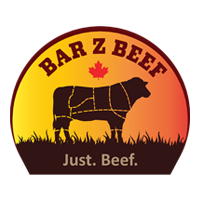When it comes to beef weights, there are three different ones of which customers should be aware of.
The first is “Live” weight. This is what the animal weighed on the hoof, or when it was alive.
The next is “Hanging” (carcass, or dressed) weight. This is the weight that the butcher gives us after slaughter and before the 21 day hang. The weight difference from the live to the hanging is the loss of the blood, head, hooves, hide, lungs, heart & viscera. The hanging weight is usually about 62% of the live weight.
For example, if you are buying shares of a beef from Bar Z Beef – whole, half, or quarter, this is how we determine pricing. If a 1300lb animal (live weight) would have a hanging weight of 806lbs. This is the weight we base we charges on, including the price of cut & wrap.
And now the third weight “Take home” or “Final” is what you actually receive when we deliver your beef share.
There is weight lost from the Hanging weight to Final weight during the 21 dry age hang, due to 2 reasons. There is about 4% water lost during the hanging process. Then about 35% is lost during the cutting process. This amount is variable based on two factors – the amount of fat in the beef and the other is the cuts the customer requests. Higher fat will mean more loss. Also, the more boneless cuts requested the lower the final weight.
Dry Hanging – Why? Hanging a beef for 21 days as we do helps improve tenderness. This is called aging and it allows the enzymes to break down the proteins and improve the eating quality. It also allows the development of flavours associated with the aging process.

